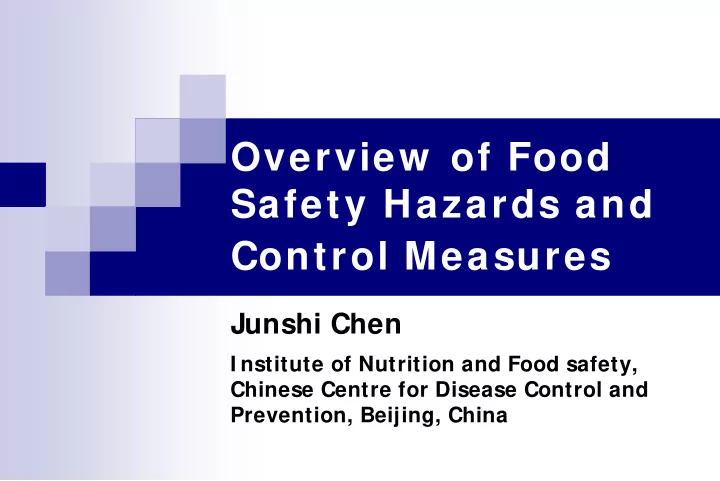

Overview of Food Safety Hazards and Control Measures Junshi Chen I nstitute of Nutrition and Food safety, Chinese Centre for Disease Control and Prevention, Beijing, China
Outlines � I ntroduction � Microbial hazards vs. chemical hazards � Principles of control measures � Government roles on food safety control � I ndustry roles on food safety control
Hazard vs. Risk � HAZARD: A biological, chemical, or physical agent in food that may have an adverse health effect. � RI SK: A function of the probability of an adverse effect and the magnitude of that effect, consequential to a hazard(s) in food. � RI SK MANAGEMENT: The process of weighing policy alternatives to accept, minimize or reduce assessed risks and to select and implement appropriate options. (FAO/ WHO. 1995. Application of risk analysis to food standards issues. Report of the Joint FAO/ WHO Expert Consultation. Geneva, 13-17 March 1995. p-6 (ftp:/ / ftp.fao.org/ es/ esn/ food/ Risk_Analysis.pdf ).
Challenges of food safety issues to developing countries � Weakness in national food control system; � Outstanding agricultural product contamination due to numerous small farms; � Large number of small food producers. A picture that could not be changed in a short period.
Different nature of m icrobial hazards vs. chem ical hazards Microbial Hazard Chemical Hazard Hazards can enter foods at many � Hazards usually enter foods in the � points from production to raw food or ingredients, or through consumption. certain processing steps (e.g. The prevalence and concentration acrylamide or packaging migrants). � of hazard changes markedly at The level of hazard present in a food � different points along the food after the point of introduction often production chain. does not significantly change. Health risks are usually acute and � Health risks may be acute but are � result from a single edible portion generally chronic. of food. Types of toxic effects are generally � I ndividuals show a wide variability � similar from person to person, but in health response to different individual sensitivity may differ. levels of hazard. Food safety risk analysis – A guide for national food safety authorities, FAO Food and Nutrition Paper 87, 2006, Rome.
I m portant m icrobial hazards � Bacteria – S almonella, Campylobacter, Listeria, Clostridium botulinum, Escherichia coli O157:H7; � Virus - C alicivirus (including norovirus), Rotavirus, Hepatitis A virus; � Parasites – T richinella, Giardia, Sarcocystis Cryptosporidium; � Zoonosis – BSE, C ampylobacteriosis, Salmonellosis, ; � Natural toxins – M ycotoxins (aflatoxins, ochratoxin A), S hellfish toxins, Glycoalkaloids, Lectins.
I m portant chem ical hazards � Heavy metals – Pb, Cd, Hg; � Pesticide residues; � Veterinary drug residues; � Environmental pollutants – POPs, e.g. dioxins; � Hazardous chemicals generated during cooking process – acrylamide, 3-MCPD, PAHs, HCAs, etc. � Radionuclides.
Different view s on the im portance of m icrobial hazards vs. chem ical hazards � I mpact on health – microbial > chemical; � Consumer perception – chemical > microbial, even food additives; � Government (developing countries) – almost same as consumer; � I ndustry – subject to government regulations.
Principles of control m easures � Whole food chain management; � Major challenge - numerous small suppliers; � Mainly rely on industry self control, not mainly rely on government inspection, in particular not rely on sampling and testing, although necessary.
Governm ent roles on food safety control � To develop science based policies, laws, regulations, standards, with emphasis on code of practice; � To carry out well planned capacity building activities; � To carry out transparent and sustainable risk communication; � Encourage third part inspection, certification and accreditation.
I ndustry roles on food safety control � To be honest and credible; � To comply with government regulations and standards; � To active participate in risk communication; � To develop industry/ private food safety standards, e.g. GFSI .
General control m easures � I n compliance with WTO agreements and international/ national standards; � Emphasis on Code of Practice, including GAP, GMP, HACCP, etc.; � Risk based import/ export control; � Strengthen role of industry association.
Conclusions � The major challenge on supply chain food safety to developing countries is the numerous small producers and suppliers. � Control should move from end product inspection and testing to the whole food chain process control. � Capacity building should be the priority of national regulatory control system. I t is also necessary for facilitating fair international food trade.
Recommend
More recommend